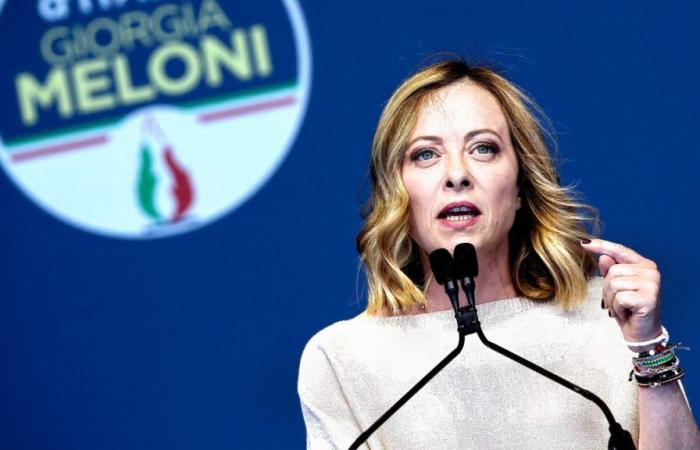It’s 7 a.m. on this back-to-school day in Italy. Alarm clocks ring to get the children out of bed and the first rays of sunlight pierce the clouds clinging to the mountain peaks of Abruzzo. The morning espresso swallowed and the school bag prepared, the streets come alive in Allezzano, a town of 40,000 inhabitants in the center of the country. Dressed in their azure blue school aprons, the little ones frolic to meet their classmates in front of the primary school. The parents kiss each other, tell each other about their vacations, their hands twirling and their accents singing, a summary of the charm of Italy. Under the playground, the teachers count their students: “17, 18… here we are all. The maximum is 27 children, but this figure seems impossible to reach today. Full classes no longer exist,” observes Raffaella, a teacher for twenty years.
About fifteen kilometers to the north, in the village of Rosciolo dei Marsi, the euphoria of back to school is a distant memory. Perched in the mountains, the Romanesque church of Santa Maria rings its bells in the deserted streets paved with white rocks. Here, wild vines colonize the facades in pastel purple or olive colors, and the shutters of the houses remain closed. The decor appears picturesque, the atmosphere timeless. On the village square, only a small café is putting up resistance. At the counter, a few old men and a handful of workers. Among them, Alberto, 55, grew up here before leaving to work in Rome in his youth. “Fifty years ago, swarms of kids played in the streets, there were cafes, farms, a nursery… But the population has shrunk, going from 1,500 inhabitants in the 1980s to less than 400 today . » Symbol of the era, the premises of the old school where Alberto studied as a child have been converted into elderly club (“circle of elders”).
“Demographic winter”
Scientists have given a name to the void that invades Italian villages and schools: “demographic winter”. A phenomenon as insidious as it is dizzying began in 1993, the year when the birth curve fell below that of deaths in the peninsula. Thirty years later, Italy combines the most aging population in the world, behind that of Japan, with one of the lowest fertility rates in the European Union (1.22 children per woman). Less than 400,000 children were born in the country in 2023, a sad record since the unification of Italy in 1861. A “winter” which Giorgia Meloni swore to end.
At the head of the coalition in power for two years, the leader of the nationalist and conservative party Fratelli d’Italia (Brothers of Italy), designates the fall in the birth rate as her “absolute priority”. Creation of a Ministry of Family and Natality; annual meeting of the Estates General on Births alongside Pope Francis; speech defending the traditional family delivered from the stage of the Demography Summit, the great rally of the European conservative right organized in Hungary by Viktor Orban. It is an understatement to say that Giorgia Meloni, elected in 2022 on the slogan “God, family, fatherland”, is struggling on a symbolic and rhetorical level. But what change is it making in the lives of Italians?
To support families, the coalition formed by his party, the center-right Forza Italia of the late Silvio Berlusconi and the Lega of Matteo Salvini on the far right, increased the remuneration of parental leave. It is also considering tax incentives summed up by “fewer taxes for more children” and is continuing the policy of the “universal check” bringing together all family allowances in a single benefit since 2021. Without tangible effects on births, for ‘moment.
“Blah blah…” Clara sighs when she talks about government policy. At 46, this manager of a restaurant in downtown Avezzano, like many Italian women, gave up becoming a mother so as not to sacrifice her professional life. “Having a child represents a barrier to employment for many women. Some contracts even provide that in the event of pregnancy, the company retains the right to dismiss. And all this, without counting the shortage of public crèches, which Giorgia Meloni says she wants to remedy. Keeping your job and raising a child is an obstacle course. » With 27 places for 100 children aged 3 months to 3 years in early childhood structures in 2020, Italy is in fact well below the recommendation threshold, set at 45% by the European Union (EU). In France, this rate reaches 58% – in other words, around 4 out of 10 children cannot find places to be looked after in France. In Italy, this concerns almost 7 out of 10.
A mainly cultural battle
As a result of these difficulties in reconciling family life and work, the employment rate of women in the peninsula has plateaued, making it the lowest in the EU. In the mind of Giorgia Meloni, the economic determinants are however secondary, the battle for the birth rate turning out to be above all cultural. “The roots [de cette crise] plunge not only into the counter-cyclical phases of the economy, but – and this is more dangerous – into the shifting sands of the myth of the declining birth rate and a now very widespread culture of hostility to the family. Just a few decades ago, we had children even in times of war or when we lived in poverty,” she declared on September 14, 2023, during the Demography Summit in Budapest.
In 2019, in Abruzzo, his party achieved the first victory in its history in regional elections. Since then, this mountainous area east of Rome has been considered the “political laboratory” of the Fratelli d’Italia. In Luco dei Marsi, a small village on the Fucin plain – an ancient lake that has become one of the cradles of intensive agriculture in the country – the paradoxes of Meloni’s Italy are obvious. At the end of the morning, the market is in full swing on the town hall square. In the middle of the vegetable and cheap clothing stalls, young women of North African or Albanian origin browse the stalls; on the other side of the street, seated on the terrace of a café, Italians with graying hair read the Gazzetta dello Sport, the oldest sports daily in the country. Suddenly, an engine backfires in the distance and a burgundy red van with a smashed body stops in the middle of the street. The driver, an Italian, honks once and the sliding door opens: around ten workers descend, heads bowed, shovels and hoes in hand, soaked by the morning rain.
Necessary migrants
These are Moroccan and Tunisian immigrants. Illegal or regular, they come every day to cultivate carrots, potatoes and other vegetables from the Fucin plain under the status of gangmaster. A form of modern agricultural slavery, very widespread in southern Italy, which makes them dependent on an intermediary who pays them a pittance. Behind his counter, Franco, the café manager, observes the scene without flinching and recounts how the population of his countryside has changed since his family arrived in the region in 1960. “Obviously the local Italians are racist, the majority voted for Giorgia Meloni. But they also know that we need these migrants to keep the economy running. The truth is that they take jobs that young Italians no longer want. »
The Fratelli d’Italia party won power by making an unapologetic anti-migrant speech. And if Giorgia Meloni made the birth rate her priority, it is as much for her refusal to see immigrants from non-Christian cultures build a new life on Italian soil as for her Catholic convictions. During a meeting in 2017, she spoke of “a planned and desired invasion”. In the eyes of the Italian leader and her supporters, increasing the number of births in the country responds to a need for identity. Some in his party go even further, raising the specter of “ethnic replacement”. Like Francesco Lollobrigida, the Minister of Agriculture, who declared in April 2023: “Italians have fewer children, so let’s replace them with others. This is not the way to go. » Except that since coming to power, Giorgia Meloni has been confronted with the reality of the Italian economy: the second industrial power and fourth agricultural force in the EU needs help. Under pressure from employers, the President of the Council therefore ended up granting 450,000 residence permits to foreign workers.
A “familist” policy
In response to these anxieties of migratory submersion, Giorgia Meloni promotes not a “family policy but a familist policy”, specifies Massimo Prearo, researcher in political science at the University of Verona. “She is leading a campaign that uses the traditional, heterosexual, Christian family for political purposes, refocusing everything around reproduction. In his mind, if true white Italians with Catholic roots have more children, then we will have a way to counter the ethnic replacement that immigration threatens us with. » When contacted, the regional authorities of Fratelli d’Italia did not respond to our requests.
On the coast of Marche, a rural and conservative region in east-central Italy, the blue of the Adriatic Sea contrasts with the arid ocher-colored hills where fields of olive trees grow. In the town center of Ascoli Piceno, towers, bell towers and medieval buildings abound. However, it is an innocuous building which now occupies the attention of the Brothers of Italy. On the second floor are the premises of the Italian Association for Demographic Education (Aied), the Italian equivalent of family planning. “Since 1980, we have had an agreement with the Ascoli hospital to support women who wish to have an abortion. It was suddenly withdrawn from us in 2023 by the region (in Italy, the regions have health competence, Editor’s note), relates Tiziana Antonucci, the president of Aied. Since then, the possibility for women to have an abortion is no longer guaranteed in the region. » With Giorgia Meloni, the body of Italian women has become the subject of a cultural battle. His government passed a measure allowing anti-abortion activists access to public health clinics in an attempt to dissuade women from terminating their pregnancies.
An objection provided for by law
The President of the Council affirms that she is not seeking to call into question the right to abortion, legalized since 1978, but simply wants to “defend the right not to abort”. The latter, however, does not seem to be in danger: throughout the country, 70% of gynecologists declare themselves “conscientious objectors” and refuse to perform abortion, in accordance with the clause introduced in 1978 in the law on abortion. In Abruzzo or the neighboring Marche region, this percentage even reaches 80%. Giorgia Meloni has three years left to deploy her pronatalist policy, before the next legislative elections in Italy. Until then, there is no doubt that its supporters, like its detractors, will have their eyes riveted on the birth curve.






